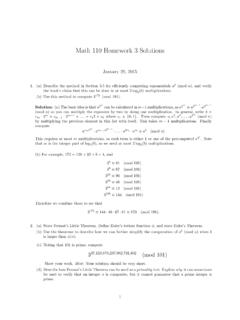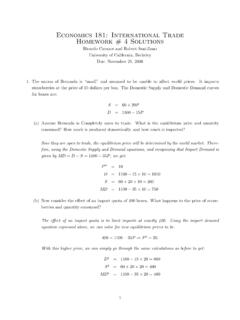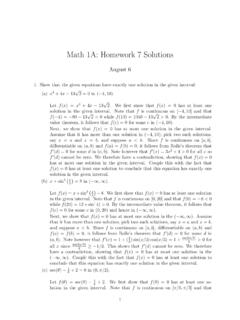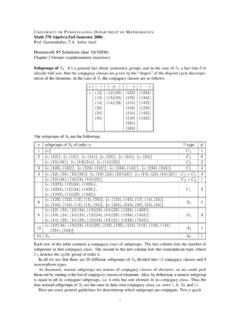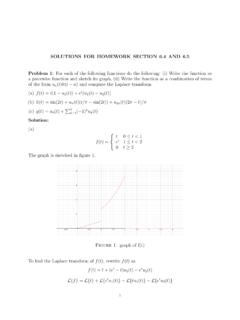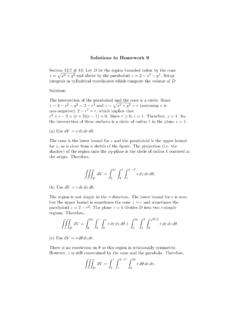Transcription of ASTR 1010 Homework Solutions - UGA
1 ASTR 1010 Homework Solutions Chapter 1 24. Set up a proportion, but be sure that you express all the distances in the same units ( , centimeters). The diameter of the Sun is to the size of a basketball as the distance to Proxima Centauri ( LY) is to the unknown distance (X), so ( 1011 cm) / (30 cm) = ( LY)( 1017 cm/LY) / (X) Rearranging terms, we get X = ( LY)( 1017 cm/LY)(30 cm) / ( 1011 cm) = 108 cm = 103 km = 8510 km In other words, if the Sun were the size of a 30-cm diameter ball, the nearest star would be 8510 km away, which is roughly the distance from Los Angeles to Tokyo. 27. The Sun s hydrogen mass is (3/4) ( 1030 kg) = 1030 kg. Now divide the Sun s hydrogen mass by the mass of one hydrogen atom to get the number of hydrogen atoms contained in the Sun: ( 1030 kg) / ( 10-27 kg/atom) = 1056 atoms. 29. The distance from the Sun to the Earth is 1 AU = 108 km = 1011 m. The light-travel time is the distance, 1 AU, divided by the speed of light, , time = distance/speed = ( 1011 m) / ( 108 m/s) = 103 s = 499 s = minutes.
2 34. Since you are given diameter (D = cm) and angle, and asked to find distance, you need to rewrite the small-angle formula as d = (206,265)(D) / ( ). (a) = 1 degree = 3600 arcsec, so d = (206,265)(D) / ( ) = (206,265)( cm) / (3600) = 149 cm = m. (b) = 1 arcmin = 60 arcsec, so d = (206,265)( cm) / (60) = 8938 cm = 89 m. (c) = 1 arcsec, so d = (206,265)( cm) / (1) = 536,289 cm = 5363 m. 35. Once again you are given D (= 2 mm) and angle (1 arcminute = 60 arcsec), and asked to find distance, so you need to rewrite the small-angle formula as d = (206,265)(D) / ( ) = (206,265)(2 mm) / (60) = 6876 mm = m. 36. In this problem you re given distance (384,000 km) and angle (1/2 = 1800 arcsec), so you can use the form of the small angle formula given on pg. 9 of your textbook: D = ( )(d) / (206,265) = (1800)(384,000 km) / (206,265) = 3351 km. Chapter 2 29. Andromeda arrives at a position in the sky 4 hours later than Cygnus. Therefore on July 21, Andromeda will be highest in the sky at 4 34.
3 (a) For an observer at the north pole, Figure 2-10 would have the Earth s north pole and the north celestial pole at the top of the diagram. (b) For an observer at the equator, Figure 2-10 would have the Earth s poles and the celestial poles at the sides of the diagram, 90 away from the top. (c) Since the north pole is at 90 N latitude and the north celestial pole is 90 above the northern horizon there (part a), and since the equator is at 0 latitude and the north celestial pole is 0 above the horizon, the rule is justified. (d) In the southern hemisphere, one's latitude is equal to the angle between the south celestial pole and the southern horizon. 37. If you were standing at either pole, the visible stars would all be circumpolar. At the equator none of the visible stars would be circumpolar. Circumpolar stars never rise or set. At the poles the diurnal circles of stars would be horizontal circles around the north celestial pole (Figure 2-11b), and at the equator the celestial poles are on the horizon so that the diurnal circles must cross the horizon (Figure 2-11c).
4 40. Your latitude (40 ) is the angular elevation of the north celestial pole above the northern horizon. Your latitude is also the angular distance, along the meridian, from the zenith to the celestial equator. (a) At noon on the day of the vernal equinox, the sun is on the celestial equator since the ecliptic crosses the celestial equator on that day. So the equinox is 90 40 = 50 above the southern horizon. (b) At noon on the date of the winter solstice, the Sun is south of the celestial equator. So the Sun is 40 + = from the zenith, which is 90 = above the southern horizon. 42. At Mumbai at 19 north latitude the Sun is at the zenith at midday twice during the year, once just before June 21, as the Sun moves northward, and once just after June 21, as the Sun moves southward. On June 21, the Sun is at the zenith at north latitude. Chapter 3 26. (a) Third quarter. (b) New. (c) Waning gibbous. (d) Waxing gibbous. All of these answers can be verified by looking at Figure 3-2.
5 27. The Moon crosses the meridian when it is (a) a new moon at noon, (b) a first quarter moon at sunset, (c) a full moon at midnight, (d) a third quarter moon at sunrise. Again, refer to Figure 3-2. 31. (a) It takes the Moon days to make a complete orbit of the Earth, , it takes days to go 360 , which is a rate of 360 /( days 24 h/day) = /hour. So, to move = will take a time = / ( /hour) = hours (= 55 minutes). (b) In a 12-hour period, the Moon will move 12 hours ( /hour) = , an angle that is greater than the separation of the pointer stars in the Big Dipper and is certainly noticeable. 36. The synodic month would be shorter than the sidereal month. Look at Figure 3-5. Imagine the directional arrow for the Moon's orbit around the Earth to point in the clockwise direction, instead of the counterclockwise direction. If that were to occur, then what's labeled as point 4 would occur before what's labeled as point 3, meaning that the synodic month would be shorter than the sidereal month.
6 43. (a) If the Moon s diameter were doubled, going from an angular size of to an angular size of 1 , there would be more total solar eclipses because the opportunity to cover the Sun s disk would be increased. (b) If the Moon s diameter were halved, going from an angular size of to an angular size of , then there would be no total solar eclipses because the Moon would not be large enough to cover the Sun s disk (which has an angular size of ). Each eclipse that is now total would become an annular eclipse. Chapter 4 33. Mercury's synodic period S = days = years. Since Mercury is an inferior planet, we must use the first equation in Box 4-1 on page 71: 1/P = 1/E + 1/S = 1/1 + 1 = 1 + = So, P = 1 / = years = 88 days (as shown in Table 4-1 on page 70). 36. Mercury takes longer to go from greatest western elongation to greatest eastern elongation than vice versa because the orbital distance is greater, as can be seen in Figure 4-6.
7 This can be verified with the dates, too, , February 24 to April 8 is 43 days, while April 8 to June 20 is 73 days. 39. Since the comet orbits the Sun, you may use Kepler's 3rd law, P2 = a3, where P is in years and a is in AU. (a) P = 64 years, so P2 = 4096. Then a = cube root of 4096 = 16 AU. (b) The distance between perihelion and aphelion equals the major-axis, , two times the semi-major axis or 2a. So, if the comet is AU from the Sun at aphelion, then it must be (2 16 AU) AU = AU from the Sun at perihelion. 43. Newton's law of universal gravitation states that the gravitational force is proportional to the masses of the two objects and inversely proportional to the square of their separation. So, if the mass of the hypothetical planet is 4 times greater than the mass of the Earth, then that would increase the gravitational force by a factor of 4. But the diameter of this hypothetical planet is 4 times greater, too, meaning that you would be 4 times farther from its center.
8 Since the gravitational force diminishes as the square of the separation, being 4 times farther away would diminish the force by a factor of 42 = 16. Combining the two effects we see that the force would be increased by a factor of 4, but diminished by a factor of 16, so overall it'd be reduced by a factor of 4/16 = . So, if you weigh 160 lbs on Earth, you'd weigh only 160 = 40 pounds on the hypothetical planet. 45. If the hypothetical star's mass is 4 times greater than the mass of the Sun, then the factor (m1 + m2) in Newton's form of Kepler's 3rd law (page 86) is 4 times greater, too, since the mass of the Earth compared to the mass of the Sun (or to the mass of the hypothetical star) is negligible. If the semimajor axis of the hypothetical planet orbiting the hypothetical star is 1 AU, then that's the same as the Earth's semimajor axis. So, if (m1 + m2) increases by a factor of 4 and the semimajor axis a stays the same, then P2 must decrease by a factor of 4, which means that P must decrease by a factor of 2.
9 Since the Earth's orbital period is 1 year, this hypothetical planet's orbital period around this hypothetical star must be decreased by a factor of 2, year. 46. (a) The orbital period of the geosynchronous satellite is the same as the Earth s rotation, P = 1 day. (b) Use Newton's version of Kepler s 3rd law. In fact, if you remember that the Moon orbits the Earth much like the geosynchronous satellite does, then you can take a simple ratio of the two cases, since the mass in Newton's version of Kepler s 3rd law is the mass of the Earth and thus is the same for both the Moon and the satellite: aSatellite3 / aMoon3 = PSatellite2 / PMoon2, which leads to aSatellite3 = (aMoon3) (PSatellite2 / PMoon2) = (384,000 km)3 ([1 day]2 / [ days]2) = 1013 km3, so a = the cube root of ( 1013 km3) = 42,353 km measured from the center of the Earth. (c) If the satellite did not orbit in the equatorial plane but in an inclined orbit, it would not appear to be stationary as seen from the Earth but would move north and south of the celestial equator.
10 Also, the Earth s equatorial bulge would cause the satellite orbit to precess, thus truly making it nonsynchronous. Chapter 5 27. max = ( m K) / (106 K) = 10-9 m = nm, which is X-ray radiation. 29. The energy flux is proportional to the 4th power of the temperature. Alpha Lupus s temperature (21,600 K) is greater than the Sun s (5800 K) by a factor of 21,600 / 5800 = The flux from Alpha Lupus s surface is therefore ( )4 = 192 times greater than that from the Sun s surface. 35. (a) 1/ = ( 107 m-1) (1/22 1/72) = 106 m-1. Therefore, = 1/ ( 106 m-1) = ( 10-7 m) = 397 nm. (b) This wavelength is less than 400 nm and so is in the ultraviolet. The lines shown in Figure 5-21 are at shorter wavelengths. 37. (a) A hydrogen atom in the ground state cannot absorb an H photon because for H the atom must be in the first excited state, , n = 2. (b) Similarly an atom in the n = 2 state cannot absorb a Lyman- photon because the Lyman series begins in the n = 1 state.


